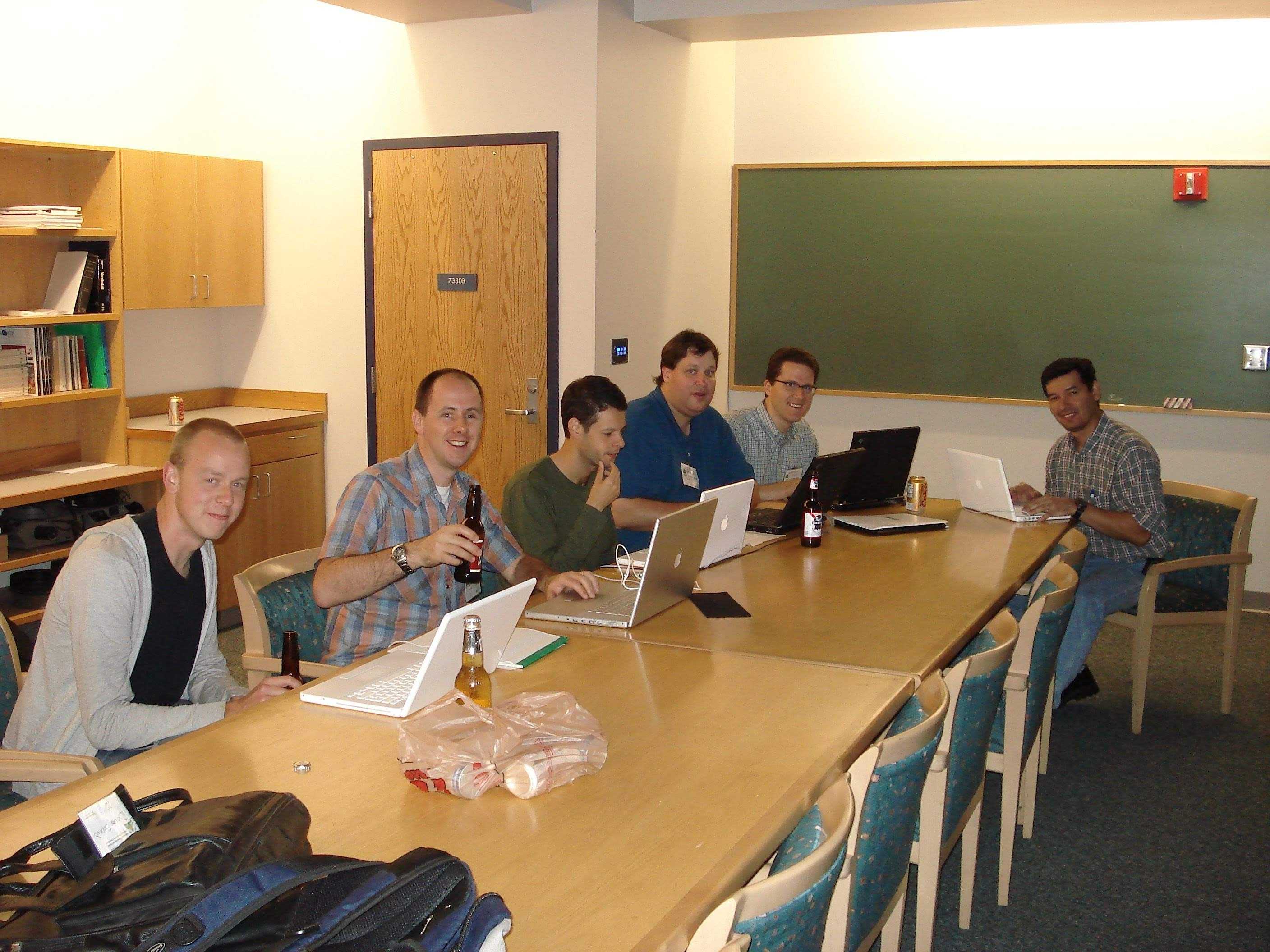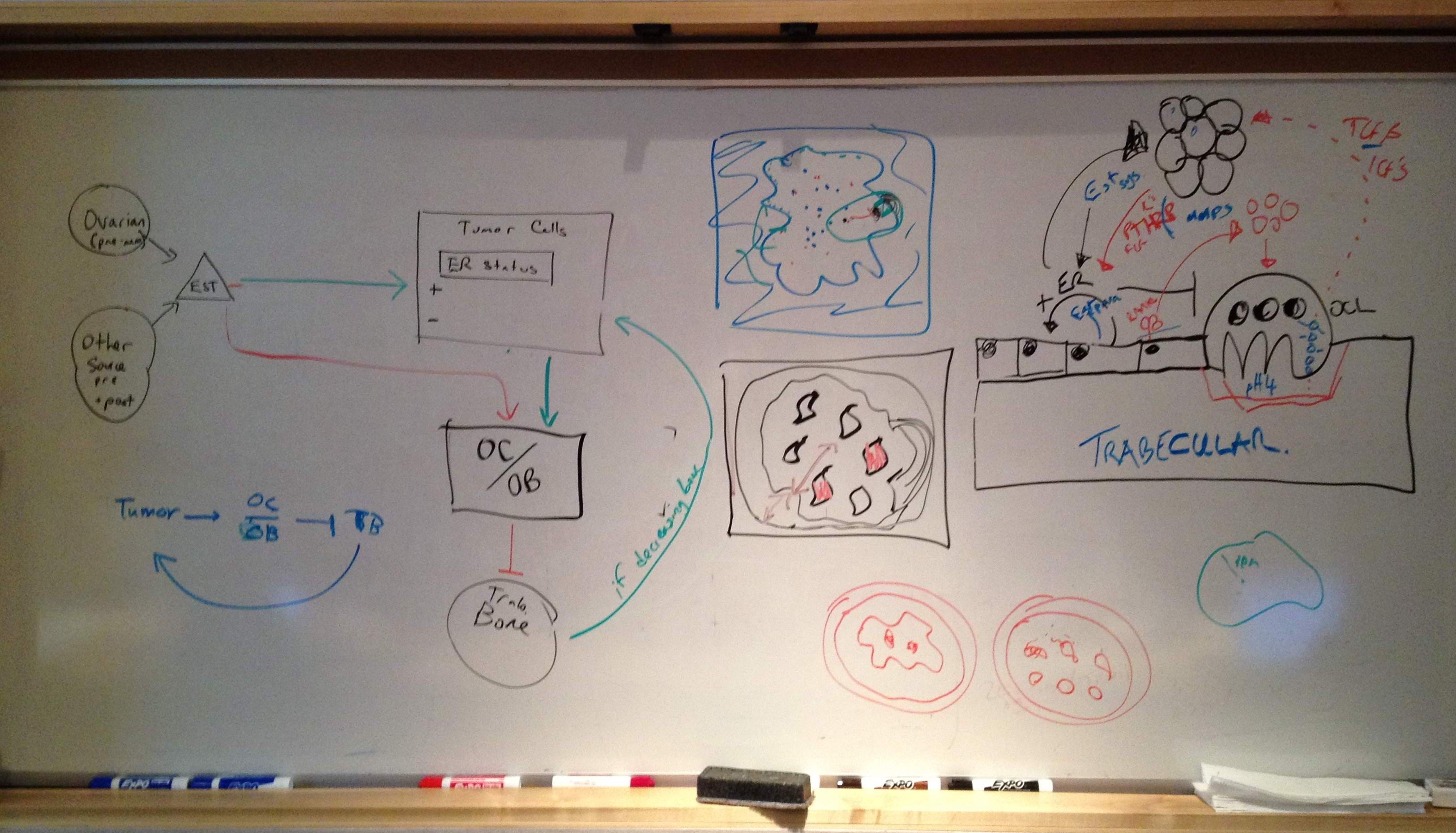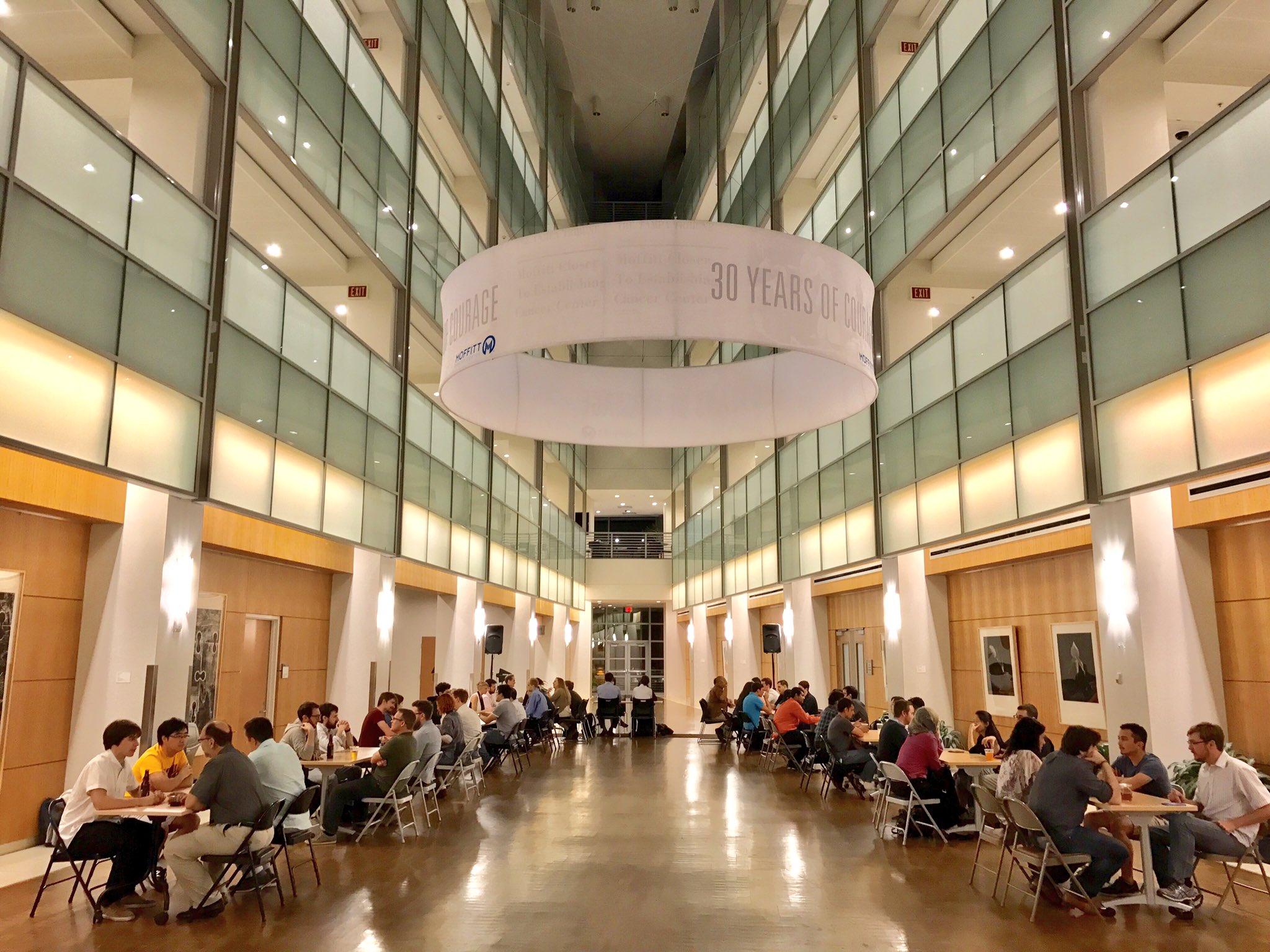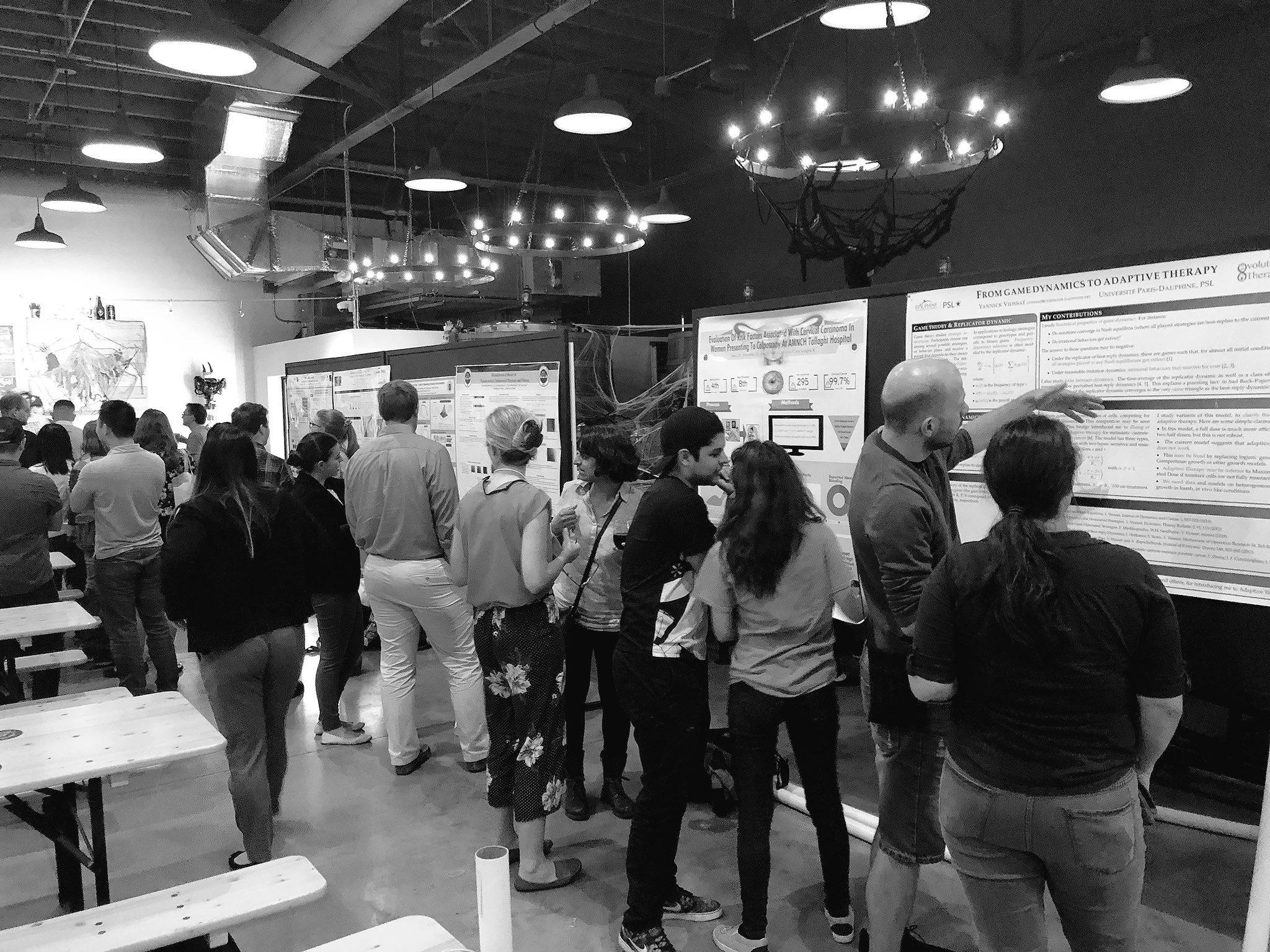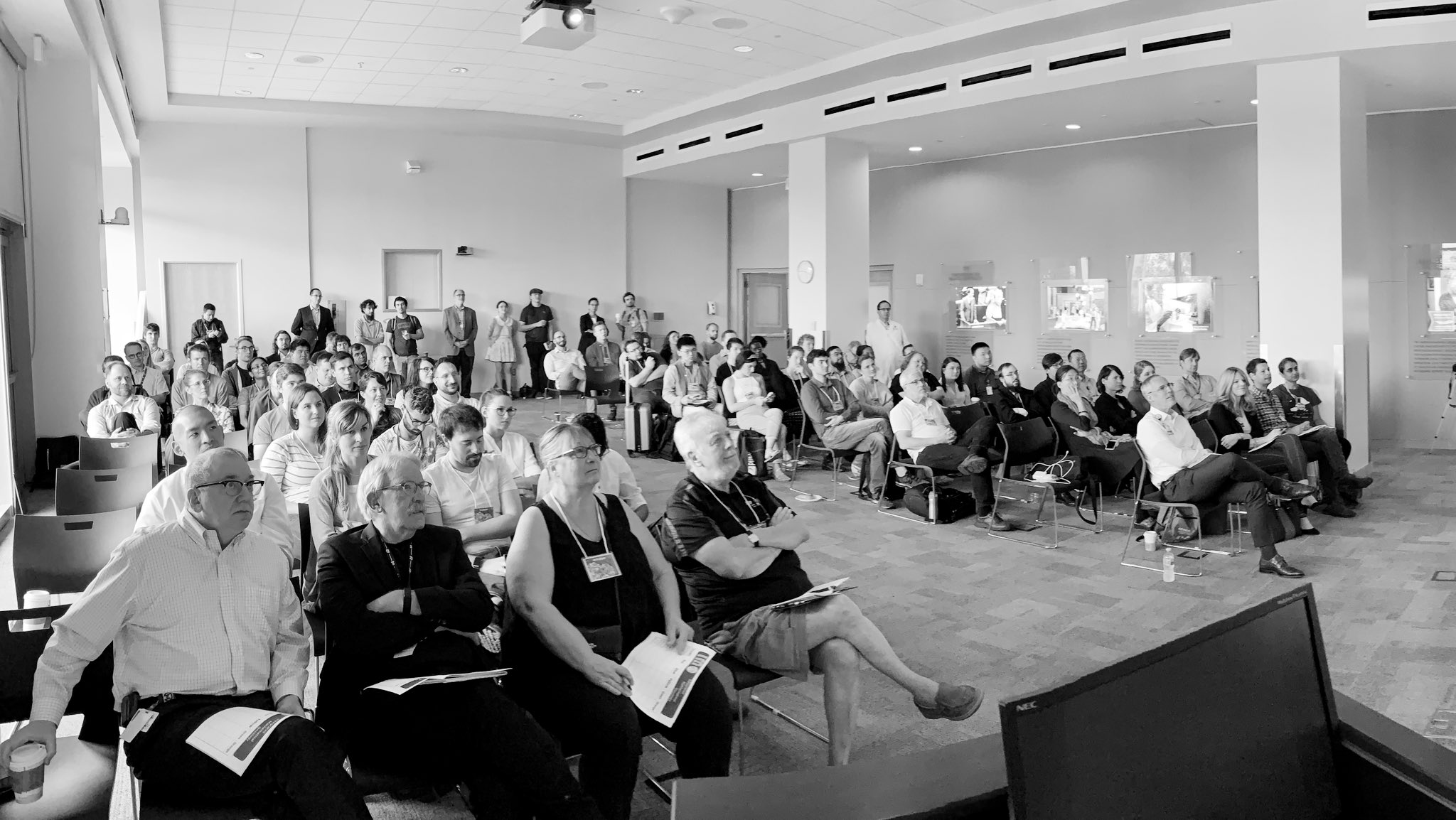IMO Workshop – A History
written by Sandy Anderson
Website: https://labpages.moffitt.org/andersona
Twitter/X: @ara_anderson
This year IMO will run its 10th annual workshop. 10 years is quite an achievement by most academic metrics, so I thought it was long overdue to have a dedicated IMO Workshop website and Twitter handle @imoworkshop. The workshop and the way that IMO specifically runs them has evolved over the course of the decade and the idea for this type of workshop actually started before IMO even began. So before you plunge into all of the cool questions, presentations and specific aims catalogued on this site, please take a little time to read how we ended up at this point.
Pre-IMO Workshops
Back in the mid 2000s I published a couple of book chapters and a paper, on tumour invasion that explicitly considered heterogeneity, that caught the attention of cell biologist Vito Quaranta (Vanderbilt). This led to a collaboration that resulted in my 1st U54 Centre grant (from the NCI, Integrated Cancer Biology Program (ICBP) initiative that eventually became the Cancer Systems Biology Consortium), my 1st (currently only) Cell paper, a blueprint for IMO, and many other things that are not directly relevant to this story. The U54 required an educational component, which initially began as more of a standard lecture format where there was a 101 for cancer biology and 101 for Mathematical Oncology (although it wasn’t called that back then).
I found the standard lecture format wasn’t good for teaching how to build models and Vito felt the same way, because nobody was learning what they didn’t already know – so we decided to completely change the format. We discussed the best way for a diverse team of scientists to integrate their skills – the answer was obvious, do science together. We were of course already doing science together but the point was more to understand each others’ tools, with the focus being on mathematical modelling as it was so new to most of the cancer scientists.
Our 1st proper brainstorming workshop ran in 2005 at Vanderbilt University and was specifically focused on how to usefully integrate mathematical models in each of the major projects in the U54. The format was morning lectures to prime the participants, afternoon brainstorming in a team format to develop the model. Key participants from the mathematical side were mainly my lab from Dundee (Heiko Enderling, Kasia Rejniak, David Basanta and Philip Gerlee) and some local Vanderbilt mathematicians. There was a winning team but no prize, it was hugely successful and Vanderbilt continued to run these workshops from 2005-2009. We participated in all of them but the move to Tampa placed our priorities firmly on Moffitt.
1st IMO Workshop
When I first moved to Moffitt in the summer of 2008 to begin IMO, with Bob Gatenby, it rapidly became clear that a workshop would help the Moffitt community better understand what a bunch of mathematicians were doing in a cancer centre. However, the first 3 years were incredibly busy with many grants being submitted and thankfully funded, in those early years we got the ICBP U54 renewed and our 1st Physical Science Oncology Centre U54. Having this strong foundation of funding and the educational expectations that come with them meant the time was ripe for the 1st IMO workshop. In December of 2011 we began with a focus on Targeted Therapy, with 4 teams each led by a clinician, mathematician and experimentalist. This week long workshop began with presentations on each of the main cancers (Breast, Lung, Melanoma and Sarcoma) then quickly moved to the brainstorming working groups. The purpose was as before, focused on mathematical model development, specifically about targeted therapy for each of these cancers. The booklet for the 1st workshop can be downloaded here, it gives a lot more detail on the leaders, their perspectives and the workshop timetable. The bulk of the week was dedicated to brainstorming and concluded with final presentations by each of the teams on Friday morning. The judges were the key leaders of Moffitt at the time (William Dalton, Jack Pledger, Tom Sellers and Julie Djeu). Even though the teams consisted of mainly internal participants, there was a winning team (led by me, Bob Gatenby and Mark Lloyd) but no prize. However, it served to motivate the Moffitt leadership about the power of this type of event both educationally and scientifically. Critically, IMO began to be seen as distinct from our biostatistics colleagues and a greater understanding of what mathematical models were and what they could do emerged.
Funding
After the 1st workshop I asked Moffitt for funding to support a prize for the following year, and secured $50,000 for IMO 2. Since then Moffitt has supported the winning team prize every year, totaling $400,000 to date and clearly illustrating their commitment to team science and IMO. While I essentially covered the expenses for the first few IMO workshops (food, travel, accommodation) from support funds, as it grew this wasn’t sustainable. When the time for the PSOC renewal came we explicitly wrote the educational piece around the workshop and included funding for 25-30 external participants. Fortunately, in 2016 we got our 2nd PSOC U54 and it has truly opened up our national and international participation.
Format
The precise format of the workshop has evolved over the years and has converged on what follows. We quickly lost the introductory lectures, brought in a requirement for a formal specific aims page as well as a poster session, but the constants have been the multidisciplinary team leads, brainstorming and the closing presentations that are independently judged.
Speed dating for scientists:
The evening before the workshop properly starts we host a get together mainly aimed at welcoming the external participants. I kick off with an overview of why we do the workshops and share for the 1st time the Scientists Inc video of the previous year’s workshop action. The speed dating begins with the external folks sitting on one side of a group of tables that the internal participants will rotate around. Each external/internal pair has 3 minutes each to introduce themselves and their science before the horn sounds and the internal participants move on. This whole process is facilitated with copious amounts of adult beverages and heavy hors d'oeuvres. Its noisy and at times chaotic and not everyone manages to speak to everyone but the key point is the ice is broken and some alliances have already begun to form.
Team Assignment:
Historically, we had 4 teams of around 10 members each. As the workshop grew we had to extend this to 5 teams with 12-15 members each. Smaller teams seem to work better, so 15 is probably too large and 10-12 about right. Each team is always led by faculty level scientists and includes a clinician, experimentalist and theoretician (normally provided by IMO). These team leads are normally established ahead of time based on the theme of the workshop, however, I generally don’t tell the IMO leader until the last minute to make sure the teams see the whole process of model development from start to finish. Assigning the team members is probably the single most difficult task in organising the workshop – making sure the teams are well balanced with the right mix of biology, theory, computation and clinical input is a non-trivial task. The participants don’t know their assignments until they arrive and the specific color of a dot on their badge gives it away on the first day of the workshop. In the past with the IMO faculty leads I used to deliberately mix up the postdocs, so you rarely got to work with your own people – that proved problematic though for continuing successful projects and we moved to having team leads work with their own people as a core being supplemented with the external participants.
Last year’s winners:
The morning of the 1st workshop day proper begins with some introductions and a presentation from the previous year’s winning team. Often this is based on their original winning presentation but also has specific details on how the $50K was spent and what science was done. This helps motivate why we are doing the workshops as well as highlighting the sort of science that makes for a winning presentation.
Working Groups:
After the morning break on day 1 the teams are given specific room assignments and form their working groups which is really how they will spend most of their time during the workshop. These brain storming sessions can be very intense and directly facilitate the dialogue between the disciplines. There is no escape for participants with all team members working together all day, every day, forcing everyone to interact in a focused and direct manner. We provide the teams with snacks and beverages and supply all food throughout the day (breakfast and lunch) – including providing dinner on the Thursday evening. Take a look at an example here of a standard workshop timetable to get an idea of the intensity.
The Question:
By the afternoon break on Monday, each team needs to have already agreed upon the question they will spend the week on. At 4pm all the teams gather and each verbally presents their question (with no slides). This forces each team to focus early on and also ups the ante in terms of the competition as everyone gets a preview of each other’s focus. You can see a video of the questions each team posed across the years on the individual workshop pages.
Poster Session:
The poster session is mainly aimed at allowing our external participants to share some of their science with the greater Moffitt research community. We deliberately have the poster session in a more public forum, such as a bar, to again facilitate easier discussion and integration but to also allow the teams to get to know one another a little better. This also highlights what skill a team member might be able to bring to the team and further adds to the competitive element of the workshop.
Specific Aims:
A single specific aims page (standard NIH format) serves as part of the pilot grant application (i.e. the $50K if they win) is required by 4pm on Thursday. These aims are also presented to the other teams during the Thursday afternoon break. These presentations can be done by any member(s) of each team and are 1-2 slides max. Each of the workshop pages shows the specific aims of the winning team (note that we only started doing this in workshop 3).
Final Presentations:
Each team must put together a 30 minute presentation by 9am on Friday. The morning of this final day is dedicated to the presentations from all teams and anyone can ask a question (including the other teams). The presentations are encouraged to be a multidisciplinary experience and presenters often switch multiple times during the 30 mins. A clear and dynamic presentation can have a big impact on the judges. Each of the workshop pages has a PDF of the winning presentation from that year.
Judging:
A key focus for IMO workshops has always been translational and as a result we have always had at least 1 lay judge be part of the panel, after the PSOC began funding part of the workshop we specifically recruited our patient advocates to fill that role (Jeri Francoeur and Robert Butler). Judges are picked based on the workshop theme but were always senior scientists and clinicians.
They are asked to judge each presentation according 5 criteria: (i) Importance of the question, (ii) Originality of the approach, (iii) Degree of success, (iv) Quality of presentation, (v) Degree of integration. Contrary to popular belief I don’t actually have a vote in deciding the winner, but do answer questions that judges might have regarding the models. In addition, the judges rank the specific aims from each of the teams and this taken together with the score for each presentation decides the winning team and runner up.
Prizes:
The winning team overall gets a $50,000 pilot grant that the team leads are considered PIs of and Moffitt graciously funds this. Each member of the winning team also gets a $75 gift card, winners certificate and of course bragging rights. The runner up team has generally not got any pilot funds, but recently given the thematic focus of the workshop, the runner up also got between $25,000-50,000. Each member of the runners up also gets a $25 gift card.
Future
In its 10th year in 2020, its not only time to reflect but to also look forward. As we close the decade on IMO workshops I’m keen to see how we might grow beyond the confines of Moffitt. I’d love to see our successful recipe adopted by others – IMO would even be willing to help make this happen if there was sufficient interest. We’ve toyed with the idea of a touring workshop, and whilst this is appealing its unclear how to practically make it happen. A key element of our success is the clinical, experimental and theoretical integration, therefore requiring the workshop to be close to the clinic and of course to have clinicians willing to participate. Having the space and resources to feed and house around 80 people is also non-trivial. I am open to discussing this, so if you have an interest in organising an IMO type workshop please do get in touch.



